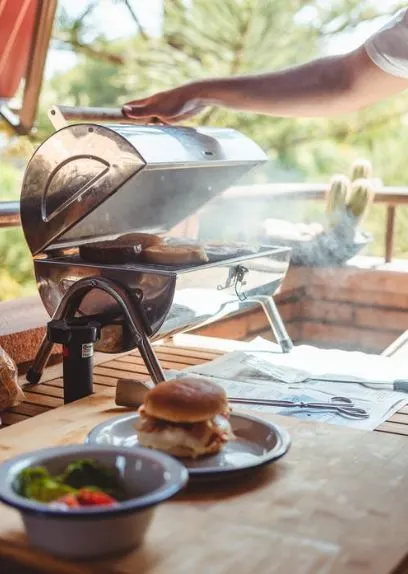This post may contain affiliate links. If you use these links to buy something we may earn a small commission. Thanks.
Many people usually do grilling in the summer and pre-winter. But in reality, there’s no time you can’t enjoy the moment. Even during post-winter, one can still enjoy a good barbecue, provided you know how to secure grill from wind since the season has the severest.
Of course, not everyone gives much thought to these tactics. But if you have a freestanding (cart) grill like Weber Genesis II E-315 or E-335, those high winds can easily knock it over. It’s not once I’ve seen on culinary platforms sad stories of the wind blowing away grills.
On the other hand, a built-in grill like Bull or Blaze has a permanently-fixed outdoor kitchen island structure. And in this case, you won’t need to worry about the high winds moving your equipment.
So, the various tips I’ve put together to secure your grill from wind apply to freestanding models. Though, I’ve also highlighted some of the tricks to anchor the grill cover, which could apply to the built-in series too.
Why You Should Secure Your Grill From Wind?
As I’ve just mentioned, a lot of users, not just you, have been using and storing their grill without securing it. But when you fail to anchor your appliance properly, you not only risk damaging and rendering it unusable. You could also end up:
- Harming the people around
If the heavy winds whip up and knock down your unsecured grill, it could roll over and injure the person/ s nearby. It could cause even more severe injuries if you’re using a charcoal grill and the hot coals fall on your lads.
- Instigating a fire outbreak
If using a charcoal grill, the hot coals brown by the wind could easily lead to a fire outbreak if they fall on a flammable surface. Even on the best gas grill, a tip or roll over to a flammable material can start a disastrous fire.
So, whichever is available, you’ll want to keep it secured in place to save yourself and others, plus their properties from potential damage.
- Ruining your delicacies
A sudden gust of wind is amongst the common causes of a flare-up in either charcoal or gas grills. And in this case, you’ll want to have the appropriate protection, else you’ll end up burning up your supposedly delicious meal.

Even without flare-ups, the grill tipping over from the high winds will also have whatever meal you were preparing all over the floor. And unless you’re okay to chew your burgers or steak with sand, make sure your equipment won’t overturn in any way.
- Messy Floors
Yes, indeed, your floor will look messy if the wind overturns your grill and your greasy meal is smeared all over the floor.
It will even look worse when you’re using a charcoal grill and the burnt ashes are blown all around the area. Thus, making the cleanup harder than it would have been if you had the grill secured.
- Incurring Unnecessary Costs
Last but not least, your unsecured grill could end up costing you unnecessary bills for repairs on the damages caused by wind. The repairs also include on the property or physical injuries caused by the grill and hot coal.
- How Long Does It Take to Bake a Potato on the Grill
- How Do You Cook A Pork Roast On A Pellet Grill?
- How to Smoke White Fish
The Various Methods on How To Secure Grill From Wind
There are various ways you can anchor your grill for it to stay in place even during heavy windy conditions. The tactics may not work in all conditions, for sure. But you should be able to count on it in most scenarios around the year.
You can secure your grill from the wind on either the wheels, bottom frame, or the cover, as shown below.
- Anchor with a heavy object
One of the dangers of having the grill in the open on a windy day is that the integrated caster wheels can roll involuntarily.
So, my first trick to secure your appliance is on these wheels while using an object heavier than its weight. It’s the easiest and cheapest of all as you can use any heavy object you can find as the anchor. A few examples include large rock/s, paint cans, sandbags, wooden blocks, et cetera.
I’d also suggest that you make sure the caster wheels (unlockable ones) don’t roll or even rock. Thus, place the heavy objects against the wheel to create some kind of a barrier- just like you do with cars.
But since the axle of the grill cart has the wheels turning in either direction, one block won’t be enough. You’ll want to set up the heavy object at the front and back of the wheel.
- Wedge the wheels with a chock
The idea here is pretty much the same as with the heavy object: block the wheels from rolling. Only that you’re now using a wedged object to create an upward slope that will be impossible to climb.
Some of the dedicated wheel chocks usually have a rubber coating to enhance the grip on the ground. But as wedging the vehicles, you’ll need a chock that’s at least one-quarter the total height of the cart’s caster wheel. The rule applies even when you use improvised wheel chock like an angled wooden block.
Also, you’ll want to secure the grill wheels at the front and back. Then, remember different materials of the block work differently on various materials.
For instance, the plastic blocks won’t work well on paved surfaces and the rubber-coated metal is likely to slip on wet grass. Thus, it might be great to have what will work best on the place you usually grill (or perhaps a few different types).
- Hold Down with Bolt Eye Hooks
If available, a couple of bolt eye hooks can help secure your grill from the wind well. The idea is to mount the hooks on the ground or walls of a structure. Then pass a sturdy rope, chain, or cord through the “eye” of the bolt hook and use it to secure the wheels or frame of the grill.
If applied appropriately, this method will offer the best anchor for your grill against the wind. But leave a gap of at least three/ four feet if you have mounted the bolt eye hook to the deck or porch.
Otherwise, you could set your structure on fire if the anchor was loose and the wind accidentally knocked over the grill.
- Use of barbecue windscreens
A dedicated windscreen can also help protect your grill from high wind, especially when preparing your meals. It comes with folding plates that you use to create some kind of shelter around the appliance. Thus, making it possible to block the wind from any direction.
Furthermore, these barbecue windscreens have some pegs that you nail to the ground to withstand even the heaviest winds. And other creative designs have bottom grooves to enhance air circulation that not only save on your gas. But also makes it possible to cook efficiently on your charcoal grill.
You can easily make your own windscreens from a large sheet of steel. But the pre-made ones are pretty cheap (from as low as $20) and easier to set up, which can be handy when using your grill for camping.
- Tie up to Structure with Bungee Cords
Last but not least, you can use a set of bungee cords to secure your grill from the wind. The method requires tying your appliance to a vertical post or horizontal rail, which should provide a tight anchor.
But since the cords usually have their own preinstalled hooks and fasteners, it requires no drilling on your structure. Also, you won’t need to worry about tying knots.
Nonetheless, we have so many types of bungee cords on the market at the moment. I’ll recommend choosing the toughest, heavy-duty options (with a high workload) that can hold your grill weight tight enough. And for extra security, you can use a couple of cords for each side of the equipment.
How to Secure Grill Cover From Wind
A good cover is very crucial in protecting your grill from harsh elements that would otherwise jeopardize performance and durability. However, the accessory has always been the victim of blowing winds. And that defeats the purpose you bought it.
In any case, the various simple ways you can secure your grill cover from wind include:
- Use a grill cover with a drawstring that you can tighten and then fasten or tie it off
- Using a grill cover that has straps you can loop around the legs and then buckle them in position
- Use a rope, bungee cords, or Velcro strips to tighten down the grill cover around the edges
- Secure the built-in cords of the grill with bolt eye hooks to the ground (mostly works for wooden floors)
- You can also secure your grill cover by adding an extra weight of something like a rock or block of wood on the bottom.
The trick could also work with something like a sandbag on top of the grill cover. But I’d be careful here as you could encourage small puddles that might compromise durability when they mix with dirt.
Get Built-in Grill or Pergola
As was mentioned earlier, you’ll find many old and recent stories of high winds blowing grills on the backside and away. So, even if you’ve never done it, you should start anchoring yours while in storage or when using on windy days.
Otherwise, you’ll end up incurring higher costs on repairs and replacements as I doubt the manufacturer warranty covers wind accidents.
If you live in highly windy areas like New Hampshire and Kansas, a built-in grill might be a more notable investment. But make sure you also build a well-anchored kitchen island with bricks.
If you still prefer a freestanding grill with a cart, a pergola with a windscreen wall could be a nice idea. In fact, not only will your grill be secure from the wind but also you’ll have a cool space to enjoy your afternoons or evenings.
